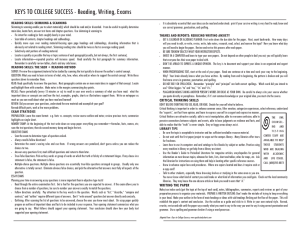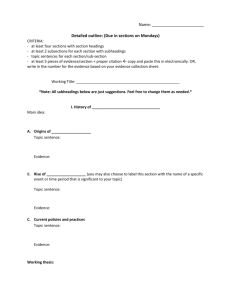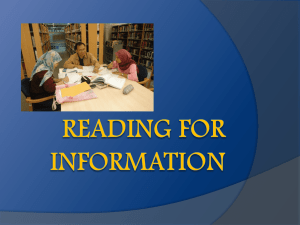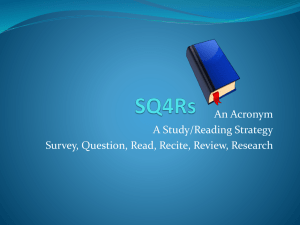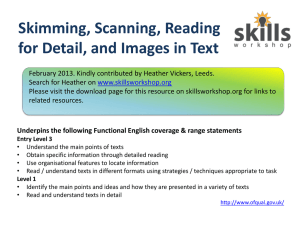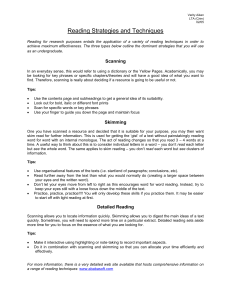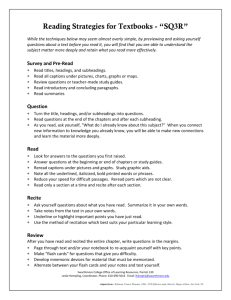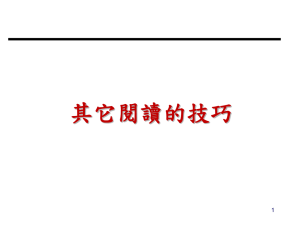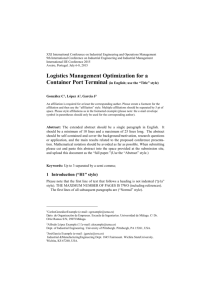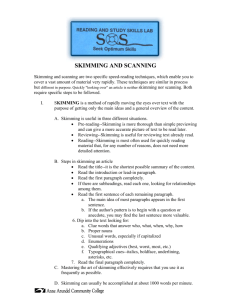Reading for a Purpose: - Disability Resources & Educational Services
advertisement
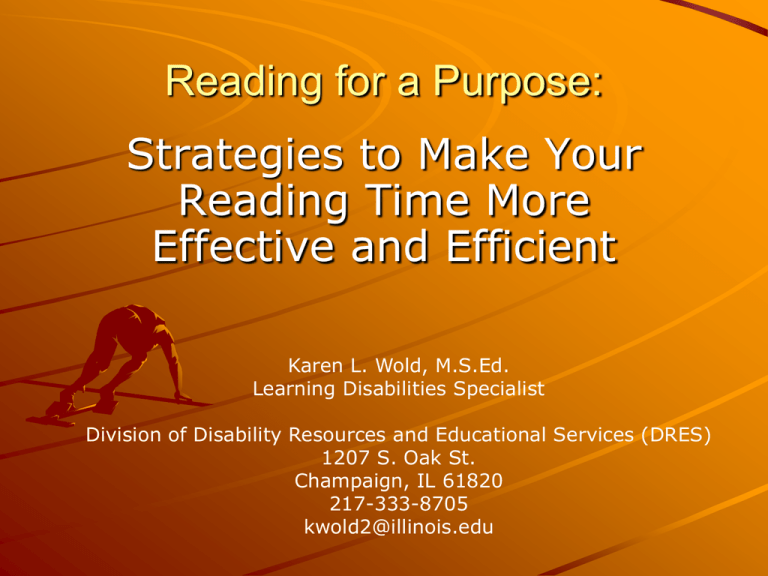
Reading for a Purpose: Strategies to Make Your Reading Time More Effective and Efficient Karen L. Wold, M.S.Ed. Learning Disabilities Specialist Division of Disability Resources and Educational Services (DRES) 1207 S. Oak St. Champaign, IL 61820 217-333-8705 kwold2@illinois.edu Description This powerpoint presentation will present a variety of purposes for reading and corresponding strategies to match those purposes. Strategies will include: skimming, scanning, and active reading strategies. Presentation Topics Why is having a purpose for reading so important? How to determine a purpose for reading. Reading for class discussion: skimming strategies Reading for a paper: scanning strategies Reading for an exam: active reading strategies Questions? Comments? Why is having a purpose for reading so important? Having a purpose for the reading you do allows you to focus on specific reading strategies to make your reading more effective. Reading “just because I have to for class” or “the professor said so” is not a sufficient purpose for reading! Having a purpose will also help to motivate you to get the reading completed. How to determine a purpose for reading. Some classes are heavily dependent on lecture notes and the book or books are used as supplementary material. Some reading (usually textbooks) is critical to read because the information will be discussed in class, or the information will not be discussed in class but you are still responsible for knowing the information for an exam. Sometimes you can choose what to read to write a paper. How to determine a purpose for reading – part two Just reading the words in a textbook is passive activity that will not allow you to remember and recall what you are learning. You need to take a more active role in the reading process. Questions to consider: What information do I need and where can I get it? For example: lecture notes, text/readings, both? Lab workbook? Reading for Class Discussion: Skimming Strategies Read the summary first, if there is one. Read the headings and subheadings. Read the words in bold or italics. If you have more time, read the first paragraph and the last paragraph of a section and the first and/or second sentence of every paragraph in between. Reading for Class Discussion: Skimming Strategies “Focused skim” method: – Know what information you need – Where might you find this info in the text? – Look at your syllabus and/or class notes to locate the info more specifically – Skim chapter titles and summaries to see if the info you need is there – Skim-read the text by looking only for the info you need For “big picture” concepts, look at the introduction and conclusion of the chapter For details, look for the terms in bold or italic type. *Modified from Learning Outside the Lines by Jonathan Mooney and David Cole, 2000. Reading For a Paper: Scanning Strategies Scanning is much more precise than skimming in that you are only looking at certain parts of the text, not the whole selection. Once you have an assignment for a paper, you can scan the readings to locate information related to the subject of your paper. Look at the Table of Contents and the Index to quickly locate information. If that does not help you to find what you need, read the syllabus to find the topic and read the headings/subheadings of the chapter or other readings that cover that topic. Read your class notes on the relevant topic. Demonstration of skimming strategy. Reading for an Exam: Active Reading Strategies 1. Decide whether to read your notes or book(s) first. If the test will not focus on one source over another, start with whichever source makes the most sense to you. Then you can move on to the source that makes the least sense to you and it may make more sense. 2. Preview chapter or lecture notes by looking at the headings and definitions/concepts (as well as pictures/diagrams if they make more sense to you then the text). 3. Turn headings/subheadings into questions and answer them. For best results, write these down or type them into a computer. By doing this, you will create your own study guide and better remember the information. 4. Engage or converse with the text – agree, disagree, question, note comments. This is essential if you want to remember the information for an exam! You won’t remember much if you just passively read the words. Reading for an Exam: Active Reading Strategies (cont.) 5. Read at least headings, subheadings, intro and summary paragraphs before class. 6. After class, use lecture notes to determine most important points to look for in reading. 7. As you are reading, if there is something that you do not understand, put a post-it note by the section where you have a question (you can even write the question on the post-it) and continue reading. You can go back and get your question answered by the TA or prof by email, office hours or class at a later time. Reading for an Exam: Active Reading Strategies (cont.) 8. Some students in math, or math-related classes, read over their notes and try to work on homework problems first. If they get stuck, then they look at the relevant section of the text and/or their notes to try and find out how to solve the problem. 9. After you finish reading each section, stop briefly to mentally review what you just read. You can also review the answers to the questions you posed from the headings. 10. In case of narratives or text with no headings, note characters, plot, other key information, etc. You can also use the first sentence of a section and turn that into a question to answer by the time you finish a chapter or section. 11. In the case of math text, read headings but work on math problems, instead of turning headings into questions to check your understanding. Resources Books College Reading and Study Skills, 8th ed., Kathleen McWhorter, 2001. Learning Outside the Lines, Jonathan Mooney and David Cole, 2000. Web sites (Reading and other Study Skills Strategies) http://www.studygs.net/reading.htm http://wwhttp://www.muskingum.edu/~cal/database/general/reading.ht ml Questions, comments? Thank you for coming to tonight’s workshop!
